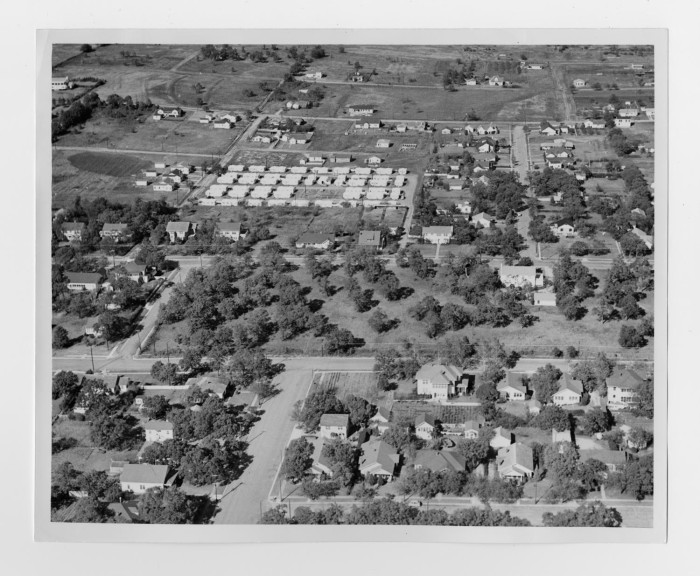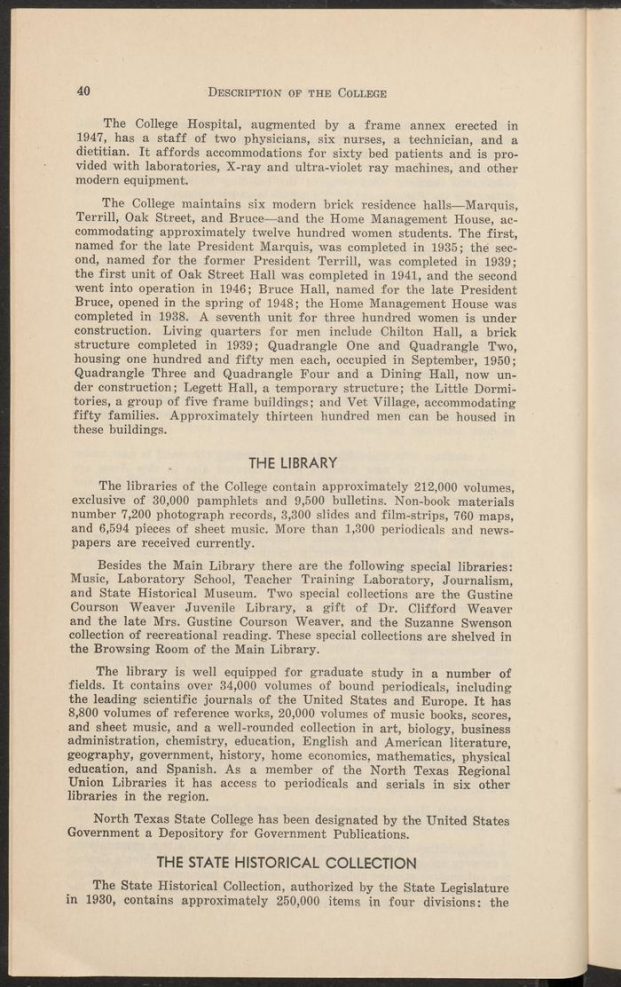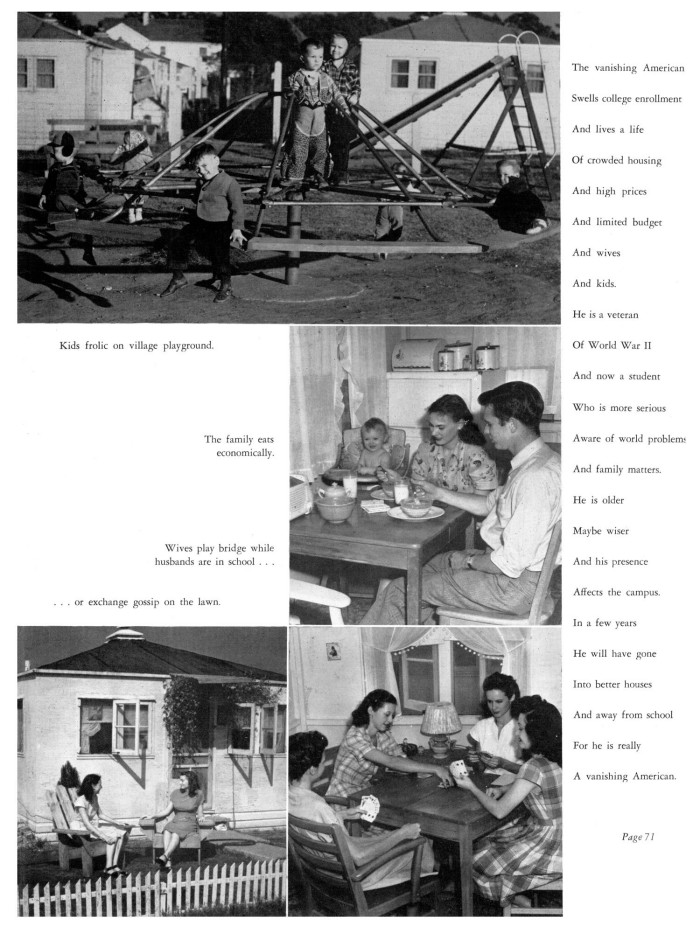The Serviceman’s Readjustment Act of 1944, more commonly known as the GI Bill of Rights, was passed to ease the military members resumption of civilian life. The bill covered healthcare, loans, unemployment compensation, education and housing. The education section was successful and popular with veterans. Unfortunately, large numbers of new students created a housing crisis on college and university campuses across the country. North Texas State College dealt with this by accepting repurposed barracks and a set of prefabricated hutments intended to house married veterans. These housing units were considered temporary, both by the college and by the federal government
The prefabricated hutments were located on five acres on Bradley Street. The site was two blocks north and six blocks west of campus. They were constructed over the Christmas break in 1945-1946. The apartments could only be rented to married veterans. The name “Vet Village” was chosen by the people who lived there. The complex housed 50 veterans and their families. There were ten single bedroom units which combined a living room and dining room with a kitchen, bedroom and bathroom. It rented for $25 a month. A double unit had two bedrooms and rented for $32.50. For most of the tenets this became home for as long as they were students. They planted gardens and lawns. There was also a playground for the children which grew to include a merry-go-round, swings, and a slide.
Residents and Denton citizens referred to the complex as “fertile valley,” due to the high birthrate at the complex. The first baby born to a resident was a boy born on August 18, 1946, to Mr. and Mrs. C. Manire. The family later added a daughter while still residents at Vet Village. The first twins were born to Mr. and Mrs. W. Caperton in 1951.
The village had three streets, named after Joan Blondell, Ann Sheridan, and Nancy Gates. Each woman was either an alumna or had performed on campus. The speed limit on the streets was 10 mph due to the number of children in the complex.
By 1947, twenty-nine residents contributed $10.00 per household to create a co-operative grocery store. The store was founded by William Kamenista and Edwin Worley. The store’s name was the Community Co-operative Association of Denton and was housed at 313 Sheridan Street. The store was incorporated, and Jack Dial was elected president, V. G. Marshal was vice president, and Elgin Phillips was secretary-treasurer. The shelving was made of apple and orange crates. They eventually added a refrigerator. The merchandise was sold at retail prices and profits were divided among the investors. Originally meant to serve the Vet Village residents, service was expanded to Denton residents by 1948.
A fire destroyed one of the prefabricated units at 111 Blondell Ave, which was occupied by Robert C. Sherman, a teacher at the Demonstration School and supervisor of the village. The family was not at home when the fire started. They were moved to a unit next door.
Residents met in the co-op store to elect a mayor and four councilmen to serve the Village. A burglary was what prompted the desire for village governance and complex improvements. William Kamenista was named mayor, and the council consisted of Bob Breckenridge, John Murphy, and Bruce Willson. The council passed a request for UNT to install additional streetlights on the complex site.
The mothers of Vet Village requested a space to be put to multiple uses – a nursery and general meeting site for the residents. Wall board was ordered to divide the storage room to create the necessary space in 1949.
Women residents could divide their time between looking after children, attending classes, and taking part in craft classes at Vet Village.
By the early fifties the school administration thought that it might become harder to fill the complex as the World War II veterans finished their educations. However, they were followed by veterans of the Korean War and non-veteran married students.
By 1959, the Board of Regents voted to tear down the hutments. An apartment complex was the planned replacement. The new structures were to be known as the Graduate Apartments. The complex would have 52, one story, units targeted to married graduate students. The school newspaper, The Campus Chat, stated that there were about 900 married students attending school at the time. Wilson, Patterson, Sowden, Dunlap and Epperly of Fort Worth designed the new complex. The Campus Chat describe the units as “diminutive.” It would contain one- and two-bedroom efficiency apartments. The new complex cost about $325,000. The complex included seven brick veneered buildings that had 53 units. The apartments had heaters, but residents wanting air-conditioning needed to install window units which added $8 in rent to cover the extra utility costs. The new complex opened in the summer of 1961. Although open to all married students, preference was given to graduate students. The residents also had access to a coin operated laundry.
By 1982, the complex was losing money. The Board of Regents raised the rent by $15.00 and made residents pay their own utility bills. Even with the small apartments, upkeep problems, and higher rent, the complex continued to have a waiting list.
The apartments were demolished in 2006. UNT, the Texas Veterans Hall of Fame, and Denton Parks and Recreation have explored the possibility of turning the lot into park to honor veterans and the area’s role in housing returning military members.

An aerial view of Vet Village in 1947.

The Catalog for 1951 -1952 gave a short description of Vet Village.

The 1948 Yucca had a two page spread that showed images of life at Vet Village.

The second page showed the children, social time for the residents, and one family at their kitchen table.




Leave a Reply